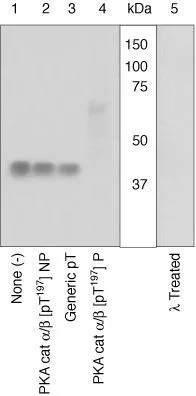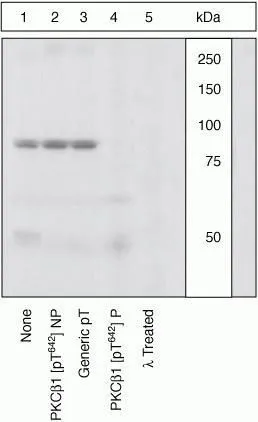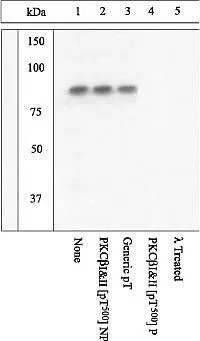
WB (peptide competition) analysis of PMA-treated K652 cell lysates using GTX25785 PKC beta 2 (phospho Thr641) antibody with the non-phosphopeptide (Lane 2), a generic (pT) peptide (Lane 3), or the phosphopeptide immunogen (Lane 4). The data show that only the immunogen phosphopeptide blocks the signal, demonstrating the specificity of the antibody. The membrane treated with phosphatase (Lane 5) eliminates the signal further verifying that the antibody is phospho-specific.
PKC beta 2 (phospho Thr641) antibody
GTX25785
ApplicationsFlow Cytometry, Western Blot, ImmunoHistoChemistry
Product group Antibodies
TargetPRKCB
Overview
- SupplierGeneTex
- Product NamePKC beta 2 (phospho Thr641) antibody - Orthogonal Validated
- Delivery Days Customer9
- Application Supplier NoteFACS: 1:20. *Optimal dilutions/concentrations should be determined by the researcher.Not tested in other applications.
- ApplicationsFlow Cytometry, Western Blot, ImmunoHistoChemistry
- CertificationResearch Use Only
- ClonalityPolyclonal
- ConjugateUnconjugated
- Gene ID5579
- Target namePRKCB
- Target descriptionprotein kinase C beta
- Target synonymsPKCB; PKC-B; PKCbeta; PKC-beta; PKCI(2); PRKCB1; PRKCB2; protein kinase C beta type; protein kinase C, beta 1 polypeptide
- HostRabbit
- IsotypeIgG
- Protein IDP05771
- Protein NameProtein kinase C beta type
- Scientific DescriptionProtein kinase C (PKC) is a family of serine- and threonine-specific protein kinases that can be activated by calcium and second messenger diacylglycerol. PKC family members phosphorylate a wide variety of protein targets and are known to be involved in diverse cellular signaling pathways. PKC family members also serve as major receptors for phorbol esters, a class of tumor promoters. Each member of the PKC family has a specific expression profile and is believed to play a distinct role in cells. The protein encoded by this gene is one of the PKC family members. This protein kinase has been reported to be involved in many different cellular functions, such as B cell activation, apoptosis induction, endothelial cell proliferation, and intestinal sugar absorption. Studies in mice also suggest that this kinase may also regulate neuronal functions and correlate fear-induced conflict behavior after stress. Alternatively spliced transcript variants encoding distinct isoforms have been reported. [provided by RefSeq, Jul 2008]
- Storage Instruction-20°C or -80°C,2°C to 8°C
- UNSPSC12352203






